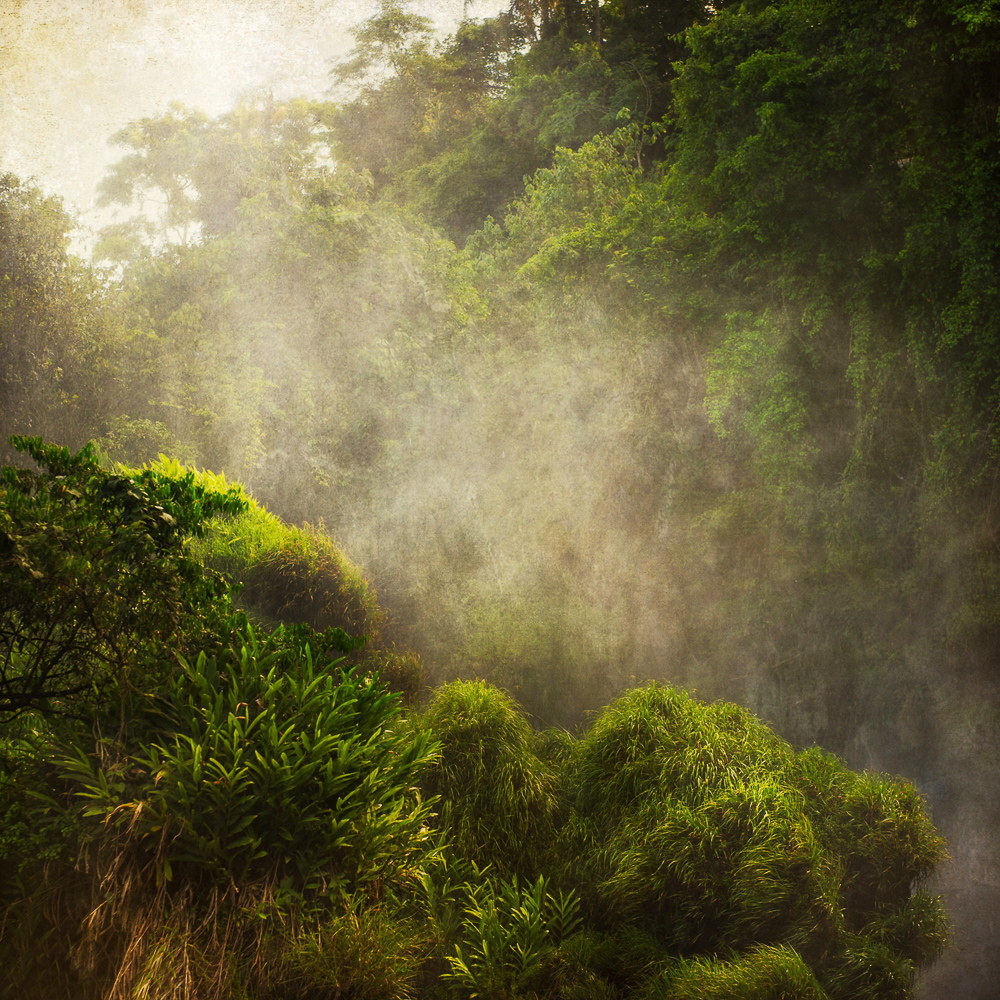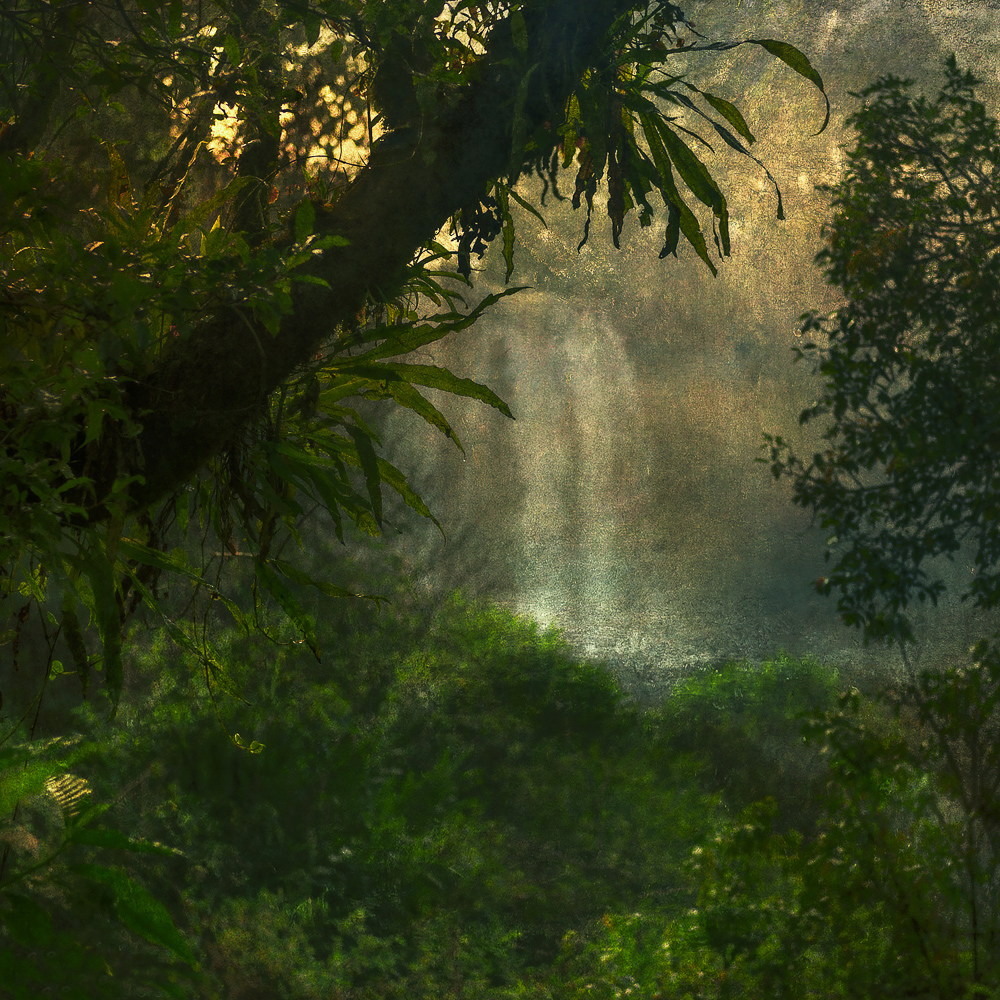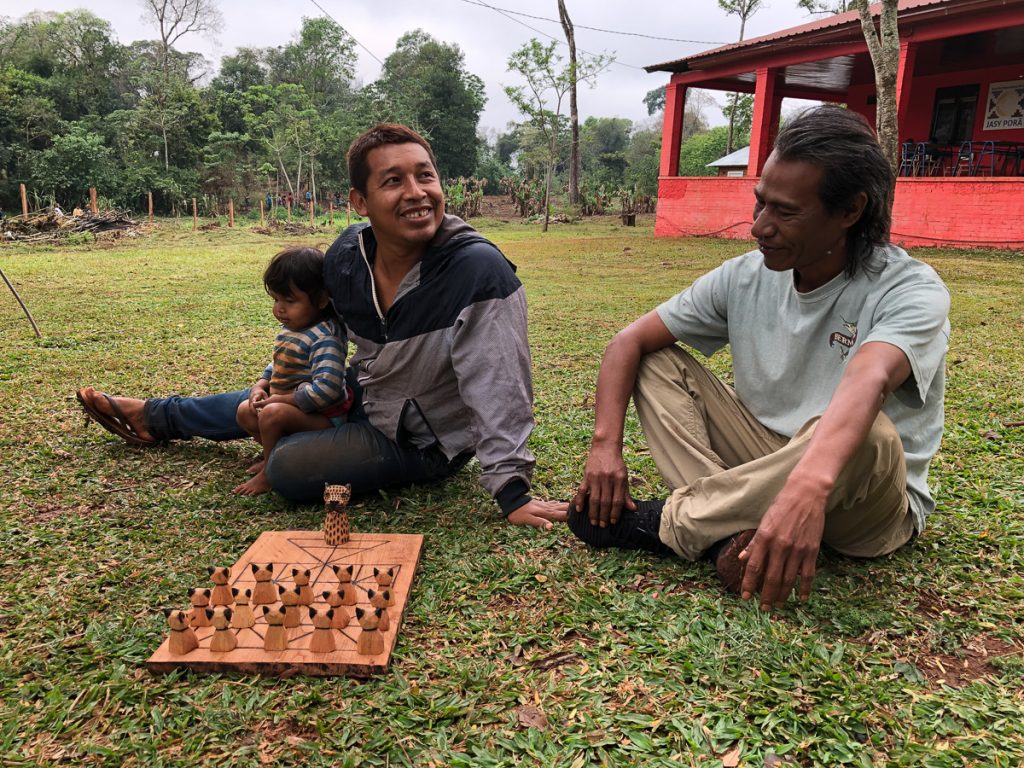Andrea Ferrari reflects on the experience of translating the Mbya origin story, compiled into Spanish by León Cadogan, but read for the first time in English.
(A message to the reader in Mbya.)
(A message to the reader in English.)
As a naturalist and poet, discovering the Ayvu Rapyta for me was like entering the rainforest I loved and multiplying the layers to be perceived. Trees, bromeliads, waterfalls and birds acquired a soul I had sensed, but the text confirmed. The ancient native culture forever merged in my heart in a profoundly spiritual way with the forest itself. Now the two are entangled: my wish to share my respect for the Mbyá Guaraní and my desire to preserve their forest.
Here you will find all the elements needed to understand the basics elements in the text and those implied in the process of translating the Ayvu Rapyta, so as to enter the text comfortably. And yet, all the while, this is a personal story of meeting a land and falling in love with it and its people. I will forever be an intruder under a spell—like you, reader, as you enter the world of this extraordinary creational text. But perhaps we, forever foreigners, can still be respectful and compassionate amidst so much cultural spoliation and social invisibility. And gain some wisdom from a peoples’ perception of the world as a rainforest created by a god who is fed by a hummingbird as it grows out of primordial darkness, creating sacred words.
The Mbya are one of the remaining groups or tribes from a vaster ethnic group called the Guaraní. The Mbya ethnicity must hold around 30.000 people distributed between Paraguay, the northeast of Argentina and the southwest of Brazil. They mostly live in small villages in what remains of the Atlantic rainforest.
You must first and foremost know that their strategy of survival has always consisted in eluding us. First, in the times of the conquest, then with the Jesuit missionaries and their communal dream. Always moving further into the rainforest, until now, cornered in its remnants, the evasion has become spiritual and cultural: They never have, and never will, fully reveal their rich cultural nuances and spiritual life to Jurua (non-native people). Therefore, it was quite providential that Leon Cadogan gained their trust in the mid-twentieth century, and they dictated him the Ayvu Rapyta, their sacred mythical text. He had helped one of them in Paraguay with legal problems, and as a sign of trust, he was given a Mbya name and the treasure of this text in village bonfire meetings.
Cadogan’s approach to it—now that I know his words closely, in that intimate relationship established during a translation—is deeply respectful. I value his evident care in reproducing the text responsibly, as I believe he was fully aware of its immense value. We are here dealing with a text with the same weight and level as the Popol Vuh, the Bible or any other creational text of importance. No less. I remember upon first reading it in a photocopy a teacher friend from Iguazú gave me, and feeling an intense awe. A text whose words are like trees sustaining and building a whole rainforest of deep spiritual strength for any who can recognize it. It hints, on several occasions, at what could be called universal truths, if you allow me; or truths which have been touched by several of the so-called foremost spiritual traditions of the world. Perhaps its value and importance lie in this; and yet, for me, it became a door into a culture that I know will forever evade me and at the same time will forever call me into its spiritual view of the world and cultural landscape of sacredness.
A world where the rainforest is a complex play of gods and creatures of different nature and yet all deserving the privilege of WORDS. For the Mbya, Ñamandu Ru Tenonde surged in primordial darkness and immediately afterwards, created language. Thus, words are a force behind every being and give life: words-souls ignite and define.
I have striven to follow that path of respect and responsibility that I perceive in Cadogan. Only that thanks to one of those coincidences Jung would call synchronicities, I came upon Roberto Benigno Benitez, a Paraguayan who has deeply studied Mbya Guaraní and is spiritually very wise. All along, he translated for me from the original in Mbya, in endless (and very pleasant) afternoons, so as to reach an English version that could both honour the original Mbya text and Cadogan´s work. None of this could have been possible without him.
We discovered on many occasions Cadogan seemed unconsciously betrayed by his upbringing, and words such as “paradise”, or “heaven” have carefully been kept closer to the Mbya original “spiritual abodes”. We also found out at times he added “padding” of connecting words and, once more, have respected the original text’s simplicity. As regards the layout Cadogan chose to give the text, this has been respected. I apologize for what may seem to be untidy or un-academic references and interruptions to the text: those are Cadogan’s, and have been preserved, as well as his copious Notes. One must bear in mind his mostly autodidactic nature as an anthropologist, as well as his technical means at the time, especially considering the monumental importance of the text he set out to write down. The flavour of it, therefore, has been consciously chosen to remain true to both the cultural and spiritual authors and owners of the text, the Mbya, and its first “translator”, Leon Cadogan. As tempting as it might have been for me as a poet, I have kept true to the original flow and nature of a text that stands on its own without any embellishing. Additionally, the version I have used is from 1997, published by the Paraguayan Anthropological Library.
There was also another synchronicity involved in this translation, which has only been completed up to Chapter 7 until now: When almost two years ago I realized there was no English version of the text, I came upon a “Call” by Kevin Murray, (dated from 2015!), who proposed it and had already contacted Rogelio Cadogan, Leon’s son. We first emailed in 2019, and ever since he has been very supportive and very kind.
To make your reading easier as you explore these fragments, chosen to showcase the crucial moments of the Ayvu Rapyta´s first part (clearly the spiritually most important one), it is useful to bear in mind there is a first creational stance in which Ñamandu Ru PapaTenonde surges, creates language and the world, and decides to share these with his children-gods, created by him as well. Thus, the Mbya pantheon has four gods: Karai, god of Fire, Ñamandu, who represents the sun, Jakaira, god of mist and shamans, and Tupã, god of thunder and water. These gods and their female counterparts live in their spiritual abodes, but take an interest in their creatures, and communication with them is achieved through the effort of praying, which for any Mbya implies dancing and singing.
Another element of importance is the concept of words as crucial to the nature of a Mbya: words-souls or names are given by the gods, who reveal them to an opygua or spiritual leader. Words imply more than a language of exchange between humans: words form the marrow bone of beings, the substance that makes us rise and be upright, and different from animals. Not that the latter have a lesser nature: they all have a place of utmost respect, but verticality holds an important role.
What happens is that upon the destruction of the “First earth/Yvy Tenonde” by a flood, most of this “Second earth/Yvy Pyau” ’s inhabitants are ‘copies’ of the original beings who now lay in the spiritual abodes of the gods. Many, but not all, have suffered this transformation into animals due to a moral mistake in the first earth. Some have the power to flow from spiritual lands into this one, as migratory birds, for example. But most that remain are considered copies and the contact with the animal or plant´s essence, one suspects, takes place with the original ones. Permission is asked upon crossing a stream, going into the rainforest, cutting a tree, in a world in which humans are not superior but coexist with all kinds of creatures, both in the concrete and in the spiritual sense.
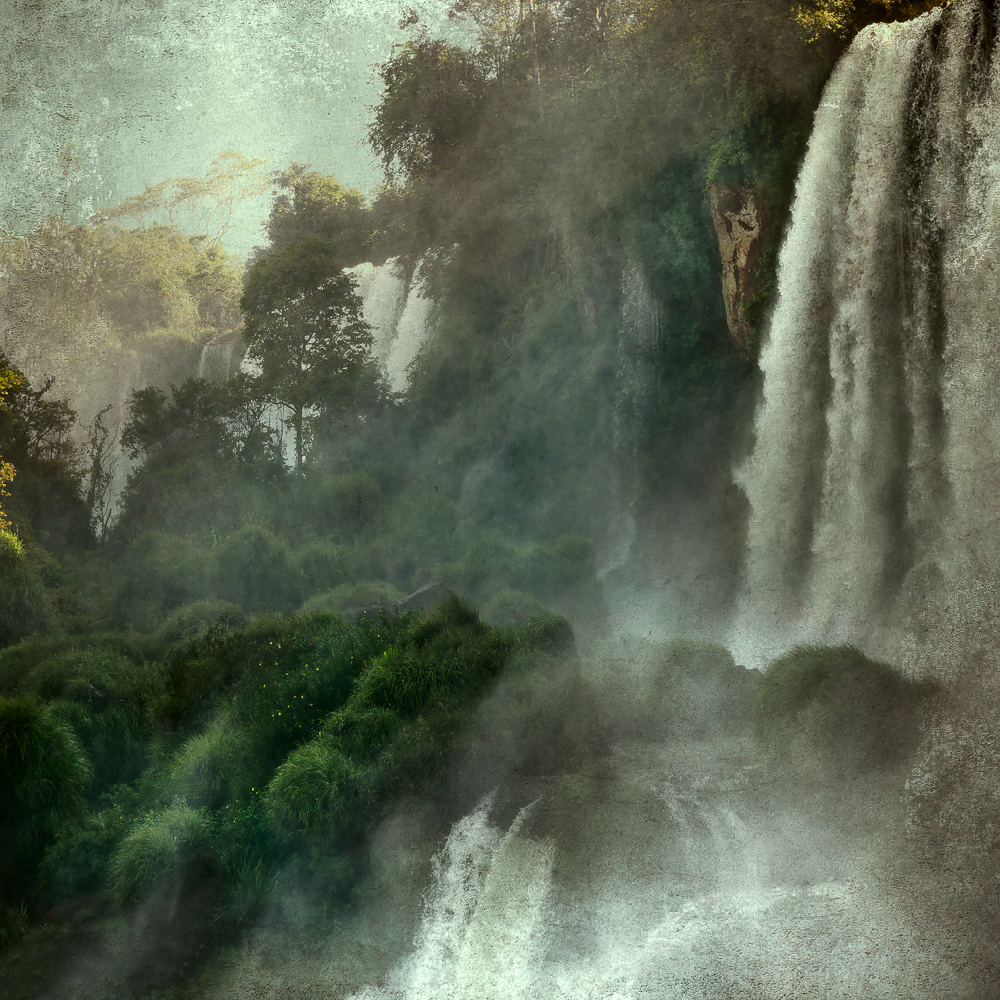
One last remark: as a naturalist, and being keenly aware of the vast knowledge and taxonomical complexities of the Mbya language to name the immense variety of species in the Atlantic rainforest (there are more than 30 varieties of the bee family classified by name by the Mbya (Cebolla Badie, 2009), to give an example), I tried very hard to identify the species mentioned in the Ayvu Rapyta. This seemed also to have been of interest to Cadogan for a couple of them, but it took me extensive research into the most varied bibliography and endless consultation with my Mbya friends, biologists, books, and scientific articles. Not all of them have been identified; it is a work that deserves more time and perhaps years of research. I am satisfied to have found and identified quite a few, which appear in my Translator’s Notes.
A great example of the process of translating this text is an occasion in which I was trying to find out which of the hummingbirds was the one mentioned in Chapter I, by showing my opygua friend Roberto a field guide with a whole page on these birds. As I asked if it was the one I thought, he simply touched the bird’s illustration with his finger and smiled. I had to confirm the species in another way, but this is how elusive and gentle a Mbya can be.
Now, here lies the Ayvu Rapyta for you, in English for the first time. As I said at the beginning, this translation is a product of a deeply personal connection with the Atlantic rainforest and its true inhabitants: those who know how to live in that world much better than we do. I feel that in this gesture of translating the Ayvu Rapyta, perhaps I am disclosing to you what should remain in mystery: evading us, as the Mbya always do. I am certain though, that these are truly only fragments of a wider, flexible, living text recited with variations in every Mbya village where there is an opy or temple, and surely this is just a frozen picture of a text, taken by Cadogan 70 years ago. My wish is that this culture receives the respect it deserves and can find it in its English readers, those who can lend an ear to gods speaking of the beginning of times, still whispering in hummingbird light.
You can read a selection of this translation here.
Jaguareté Korá, the Mbyá Guaraní strategy game
This ancient game is sometimes called “Mbyá Guaraní Chess” because it is a strategy game played in pairs by many members of this ethnic group.
It’s a game that can be played on the soil, by making a few lines and using pebbles, or on a beautiful craft made board in which wooden dogs and one jaguar fight to overpower each other.
On this board/soil, two players (one moving a sole jaguar) and the other (with 15 dogs) dispute control. In order to win, either the jaguar “eats” at least 7 dogs with its moves, similar to the ones in checkers OR the dogs corner the jaguar so that it cannot move anymore, and it loses. There is no limiting time set as in chess, but the players can agree on it, or in some particular detail which may vary, as for example the number of dogs to be eaten so the game is won. The “korá” or lair is the place from where the jaguar starts, or where it tries to avoid being cornered into
This beautiful board was made by Lidio Martinez, a musician and craftsman from Yasy Porã, a village near Iguazú Falls. He burns the wood with hot iron to create the board, as well as the animals, whose features are also made by burning. He uses cedar, a tree which is sacred for the Mbyá.
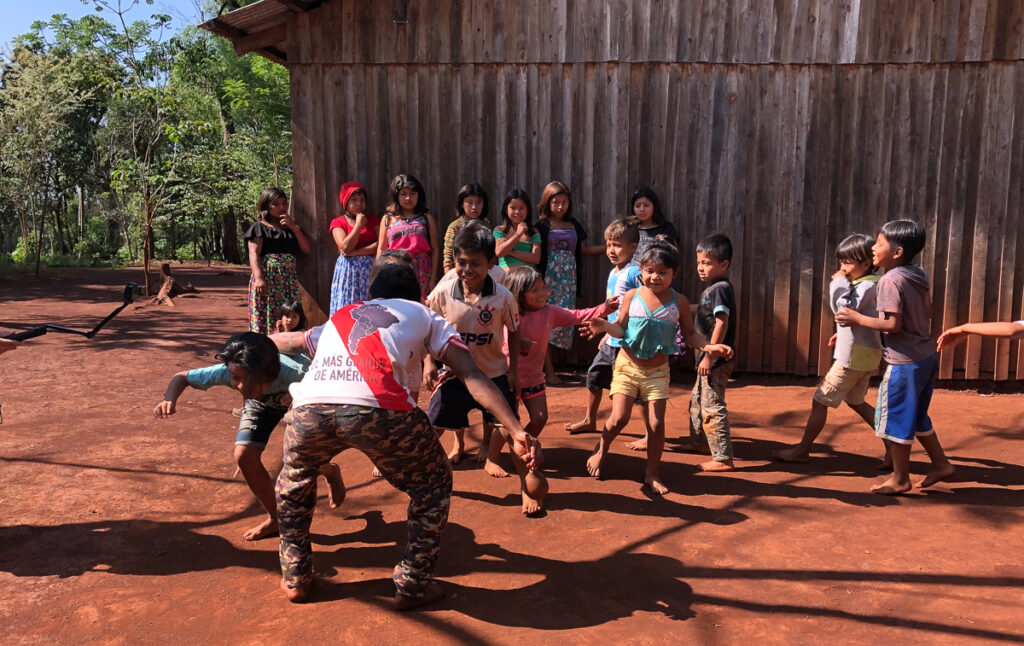
It is a game currently played by children and young people in Mbyá villages, and in the wooden version, dogs have subtly differentiated faces, making it a remarkable piece of craftsmanship. This game reflects the importance and sacred nature of jaguars for these peoples, and their respect for a species they coexist with.
Author
 Andrea Ferrari Kristeller has been an English Literature teacher for 30 years, a naturalist and a poet. She studied Literature at the University of Buenos Aires and translation with Leandro Wolfson. She did an internship at the Buenos Aires Zoo and studied to become a naturalist at EAN (Argentine School for Naturalists). She worked in wildlife rehabilitation for many years at Ribera Norte Natural Reserve, and for Fundación Bioandina in condor rehabilitation at Temaikén. She currently collaborates with several conservation programs in Misiones and other provinces by translating scientific papers or fund soliciting work into English. In 2012 she visited Misiones with her family for the first time and fell in love with its rainforest and the Mbya Guaraní culture. Since then, she has travelled there twice a year and nurtured a friendship with members of a Mbya village. She collaborated with the first Mbya-Guaraní/Spanish- Spanish Mbya Guaraní Dictionary (Rodas/Benitez, UNAM, 2018) in its Penta translator section, for the English language. She is currently translating into English the sacred text of the Mbya, the Ayvu Rapyta, in its version by Leon Cadogan, in the hope of helping this culture by raising awareness of its rich spiritual traditions. She writes poetry on nature in English, and her poems are published by several magazines in the US and the UK (The Weekly Avocet, The Avocet, The Dawntreader, and Erbacce). She has written a nouvelle, The Land without, whose English and Spanish versions await publication in 2021, for which she received an Honorable Mention at the Writers of the Future sci-fi and Fantasy literary contest in 2018. She is currently learning the Mbya Guaraní language with Mbya teachers.
Andrea Ferrari Kristeller has been an English Literature teacher for 30 years, a naturalist and a poet. She studied Literature at the University of Buenos Aires and translation with Leandro Wolfson. She did an internship at the Buenos Aires Zoo and studied to become a naturalist at EAN (Argentine School for Naturalists). She worked in wildlife rehabilitation for many years at Ribera Norte Natural Reserve, and for Fundación Bioandina in condor rehabilitation at Temaikén. She currently collaborates with several conservation programs in Misiones and other provinces by translating scientific papers or fund soliciting work into English. In 2012 she visited Misiones with her family for the first time and fell in love with its rainforest and the Mbya Guaraní culture. Since then, she has travelled there twice a year and nurtured a friendship with members of a Mbya village. She collaborated with the first Mbya-Guaraní/Spanish- Spanish Mbya Guaraní Dictionary (Rodas/Benitez, UNAM, 2018) in its Penta translator section, for the English language. She is currently translating into English the sacred text of the Mbya, the Ayvu Rapyta, in its version by Leon Cadogan, in the hope of helping this culture by raising awareness of its rich spiritual traditions. She writes poetry on nature in English, and her poems are published by several magazines in the US and the UK (The Weekly Avocet, The Avocet, The Dawntreader, and Erbacce). She has written a nouvelle, The Land without, whose English and Spanish versions await publication in 2021, for which she received an Honorable Mention at the Writers of the Future sci-fi and Fantasy literary contest in 2018. She is currently learning the Mbya Guaraní language with Mbya teachers.

